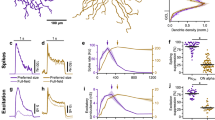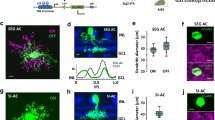Abstract
The center–surround receptive-field organization in retinal ganglion cells is widely believed to result mainly from lateral inhibition at the first synaptic level (in the outer retina). Inhibition at the second synaptic level (in the inner retina) is thought to mediate more complex response properties. Here we show that much of the sustained surround antagonism in certain on-center ganglion cells results from lateral inhibition in the inner retina, via GABAergic amacrine cells, and that the lateral conduction of this signal requires voltage-gated sodium currents. Blocking lateral inhibition in the inner retina eliminates the preference of small-center ganglion cells for small stimuli but has little effect on ganglion cells with large receptive-field centers. These results illustrate how lateral inhibition at successive synaptic stages can selectively control the size of neural receptive-field centers.
This is a preview of subscription content, access via your institution
Access options
Subscribe to this journal
Receive 12 print issues and online access
$209.00 per year
only $17.42 per issue
Buy this article
- Purchase on Springer Link
- Instant access to full article PDF
Prices may be subject to local taxes which are calculated during checkout






Similar content being viewed by others
References
Werblin, F. S. Control of retinal sensitivity. II. Lateral interactions at the outer plexiform layer. J. Gen. Physiol. 63, 62– 87 (1974).
Werblin, F. S. & Dowling, J.E. Organization of the retina of the mudpuppy, Necturus maculosus. II. Intracellular recording. J. Neurophysiol. 32, 331–355 (1969).
Werblin, F. S. Lateral interactions at inner plexiform layer of a vertebrate retina: antagonistic responses to change. Science 175, 1008– 1010 (1972).
Thibos, L. N. & Werblin, F. S. The response properties of the steady antagonistic surround in the mudpuppy retina. J. Physiol. (Lond.) 278, 79–99 ( 1978).
Barlow, H. B. Summation and inhibition in the frog's retina. J. Physiol. (Lond.) 119, 69–88 ( 1953).
Kuffler, S. W. Discharge patterns and functional organization of mammalian retina. J. Neurophysiol. 16, 37–68 (1953).
Mangel, S. C. Analysis of the horizontal cell contribution to the receptive field surround of ganglion cells in the rabbit retina. J. Physiol (Lond.) 44, 211–234, (1991).
Naka, K. I. & Witkovsky, P. Dogfish ganglion cell discharge resulting from extrinsic polarization of the horizontal cells. J. Physiol (Lond.) 223, 449–460 (1972).
Caldwell, J. H., Daw, N. W. & Wyatt, H. J. Effects of picrotoxin and strychnine on rabbit retinal ganglion cells: lateral interactions for cells with more complex receptive fields. J. Physiol. (Lond.) 276, 277– 298 (1978).
Kittila, C. A. & Massey, S. C. Pharmacology of directionally selective ganglion cells in the rabbit retina. J. Neurophysiol. 77, 675–689 (1997).
Werblin, F. S., Maguire, G., Lukasiewicz, P. D., Eliasof, S. & Wu, S. M. Neural interactions mediating the detection of motion in the retina of the tiger salamander. Visual Neurosci. 1, 317–329 ( 1988).
Schwartz, E. A. Organization of on-off cells in the retina of the turtle. J. Physiol. (Lond.) 230, 1–14 ( 1973).
Werblin, F. S. & Copenhagen, D. R. Control of retinal sensitivity: III. Lateral interactions at the inner plexiform layer. J. Gen. Physiol. 63, 88– 110 (1974).
Thibos, L. N. & Werblin, F. S. The properties of surround antagonism elicited by rotating windmill patterns in the mudpuppy retina. J. Physiol. (Lond.) 278, 101–116 (1978).
Enroth-Cugell, C. & Jakiela, H. G. Suppression of cat retinal ganglion cell responses by moving patterns. J. Physiol. (Lond.). 302, 49–72 ( 1980).
Jacobs, A. L. & Werblin, F. S. Spatiotemporal patterns at the retinal output. J. Neurophysiol. 80, 447 –451 (1998).
Daw, N. W., Jensen, R. J. & Brunken, W. J. Rod pathways in mammalian retinae. Trends Neurosci. 13, 110–115 ( 1990).
Belgum, J. H., Dvorak, D. R., McReynolds, J. S. & Miyachi, E. I. Push-pull effect of surround illumination on excitatory and inhibitory inputs to mudpuppy retinal ganglion cells. J. Physiol. (Lond.) 388, 233–243 (1987).
Conners, B. & Prince, D. A. Effects of local anesthetic QX-314 on the membrane properties of hippocampal pyramidal neurons. J. Pharmacol. Exp. Ther. 220, 476–481 (1982).
Gilbertson, T. A., Borges, S. & Wilson, M. The effects of glycine and GABA on isolated horizontal cells from the salamander retina. J. Neurophysiol. 66, 2002–2013 (1991).
Golard, A., Witkovsky, P. & Tranchina, D. Membrane currents of horizontal cells isolated from turtle retina. J. Neurophysiol. 68, 351– 361 (1992).
Djamgoz, M. B. A. & Stell, W. K. Tetrodotoxin does not block the axonal transmission of S-potentials in goldfish retina. Neurosci. Lett. 49, 233– 238 (1984).
Yang, C. Y., Maguire, G., Lukasiewicz, P., Werblin, F. & Yazulla, S. Amacrine cells in the tiger salamander retina: Physiology and neurotransmitter identification. J. Comp. Neurol. 312, 19–32 ( 1991).
Hare, W. A. & Owen, W. G. Receptive field of the retinal bipolar cell: a pharmacological study in the tiger salamander. J. Neurophysiol . 76, 2005–2019 ( 1996).
Cook, P. B., Lukasiewicz, P. D. & McReynolds, J. S. Action potentials are required for the lateral transmission of glycinergic transient inhibition in the amphibian retina. J. Neurosci. 18, 2301–2308 (1998).
Bloomfield, S. A. Effect of spike blockade on the receptive-field size of amacrine and ganglion cells in the rabbit retina. J. Neurophysiol. 75, 1878–1893 (1996).
Miller, R. F. & Dacheux, R. Dendritic and somatic spikes in mudpuppy amacrine cells: identification and TTX sensitivity. Brain Res. 104, 157–162 ( 1976).
Lukasiewicz, P. D., Maple, B. R. & Werblin, F. S. A novel GABA receptor on bipolar cell terminals in the tiger salamander retina. J. Neurosci. 14, 1202–1212 (1994).
Lukasiewicz, P. D. & Werblin, F. S. A novel GABA receptor modulates synaptic transmission from bipolar to ganglion and amacrine cells in the tiger salamander retina. J. Neurosci. 14, 1213–1223 (1994).
Dong, C. J. & Werblin, F. S. Temporal contrast enhancement via GABAC feedback at bipolar terminals in the tiger salamander retina. J Neurophysiol. 79, 2171– 2180 (1998).
Verwiej, J., Kamermans, M. & Spekreijse, H. Horizontal cell feed back to cones by shifting the cone calcium-current activation range. Vision Res. 36, 3943–3953 (1996).
Toris, C. R., Eiesland, J. L. & Miller, R.F. Morphology of ganglion cells in the neotenous tiger salamander retina. J. Comp. Neurol. 352, 535–559 (1995).
Karwoski, C. J. & Burkhardt, D. A. Ganglion cell responses of the mudpuppy retina to flashing and moving stimuli. Vision Res. 16, 1483–1495 (1976).
Belgum, J. H., Dvorak, D. R. & McReynolds, J. S. Sustained synaptic input to ganglion cells of mudpuppy retina. J. Physiol. (Lond.) 326, 91–108 (1982).
Arkin, M. S. & Miller, R. F. Bipolar origin of synaptic inputs to sustained OFF-ganglion cells in the mudpuppy retina. J. Neurophysiol . 60, 1122–1142 ( 1988).
McReynolds, J. S. & Lukasiewicz, P. D. in Neurobiology of the Inner Retina (eds Weiler, R. & Osborne, N. N.) 209– 220 (Springer, Berlin, 1989).
Belgum, J. H., Dvorak, D. R. & McReynolds, J. S. Sustained and transient synaptic inputs to on-off ganglion cells in the mudpuppy retina. J. Physiol (Lond.) 340, 599–610 (1983).
Cook, P. B. & McReynolds, J. S. Modulation of sustained and transient lateral inhibitory mechanisms in the mudpuppy retina during light adaptation. J. Neurophysiol. 79, 197– 204 (1998).
Acknowledgements
This work was supported by research grant EY01653 and core grant EY07003 from the National Eye Institute.
Author information
Authors and Affiliations
Corresponding author
Rights and permissions
About this article
Cite this article
Cook, P., McReynolds, J. Lateral inhibition in the inner retina is important for spatial tuning of ganglion cells. Nat Neurosci 1, 714–719 (1998). https://doi.org/10.1038/3714
Received:
Accepted:
Issue Date:
DOI: https://doi.org/10.1038/3714
This article is cited by
-
Signaling Mechanism for Modulation by GLP-1 and Exendin-4 of GABA Receptors on Rat Retinal Ganglion Cells
Neuroscience Bulletin (2022)
-
Adapting Laplacian based filtering in digital image processing to a retina-inspired analog image processing circuit
Analog Integrated Circuits and Signal Processing (2019)
-
The impact of inhibitory mechanisms in the inner retina on spatial tuning of RGCs
Scientific Reports (2016)
-
Directionally selective retinal ganglion cells suppress luminance responses during natural viewing
Scientific Reports (2016)
-
GABAergic neurotransmission and retinal ganglion cell function
Journal of Comparative Physiology A (2015)



